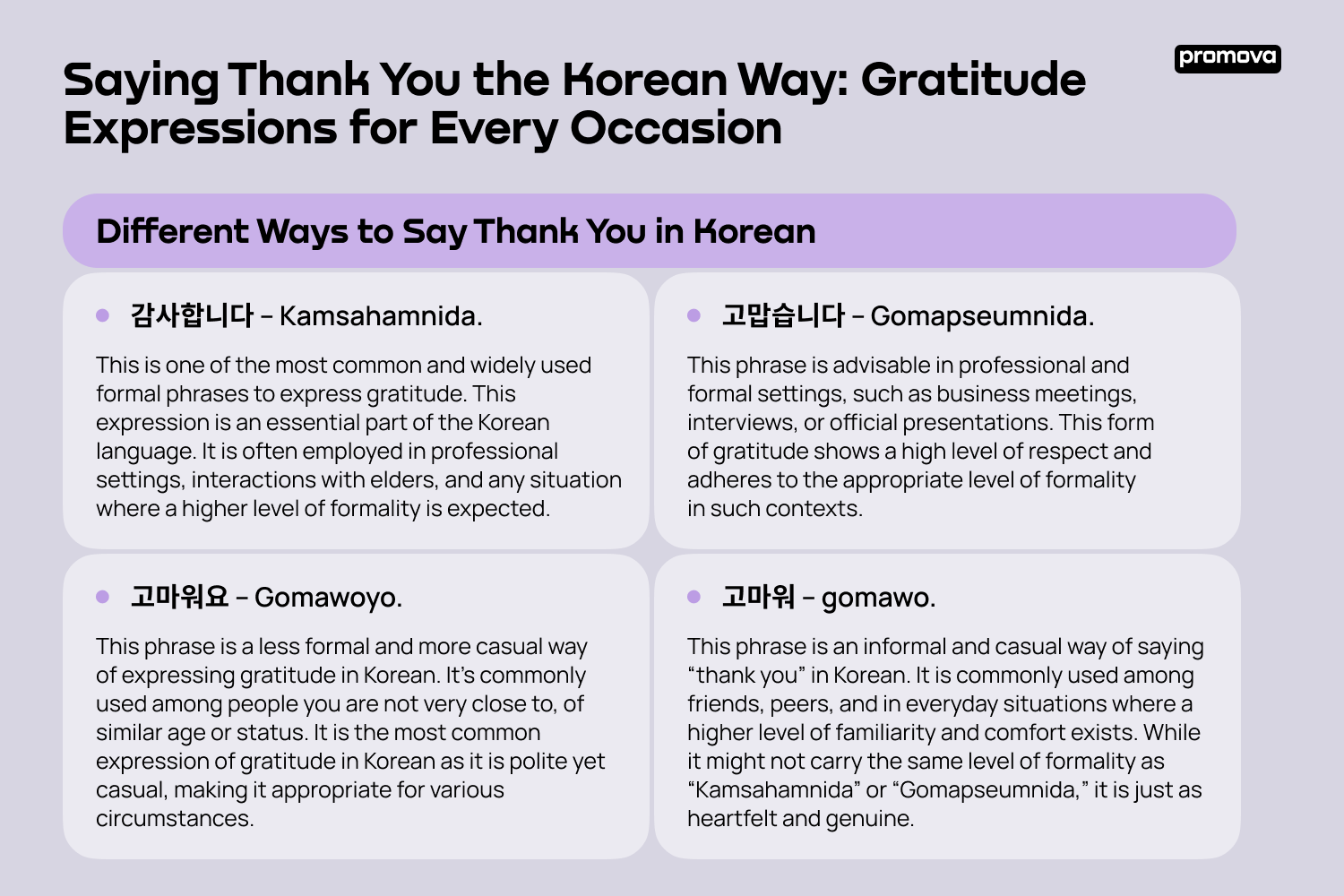Saying Thank You the Korean Way: Gratitude Expressions for Every Occasion
Contenido
Gratitude is an exciting feeling in any language. That is why knowing how to express it is essential, even for non-native speakers. Today, we will talk about different Korean thank you words and phrases. In this country, gratitude and appreciation are integral to any social interaction, whether communicating with close friends or complete strangers. Keep reading, and you’ll learn many useful expressions, cultural nuances, and other important details about saying thank you in Korean.
Cultural Context of Gratitude in Korea
In Korean society, showing appreciation and expressing gratitude is deeply intertwined with cultural values and social norms. Respect for elders, humility, collectivism, and maintaining harmony are at the core of a nation’s cultural identity, and these values greatly influence how gratitude is conveyed and received. Here are some essential points to keep in mind before learning kamsamnida meaning.
- Respect for elders and hierarchy. Korean culture places a strong emphasis on respecting older people and acknowledging their wisdom and experience. This is evident in the language and gestures used to express gratitude. Different levels of politeness and formality are employed based on age and social status. When saying formal thank you in Korean to someone older or in a higher position, locals often use honorific language and gestures like bowing to show deference and respect.
- Humility and modesty. Koreans value humility and modesty in their interactions. When receiving compliments or favors, individuals tend to downplay their own contributions and attribute the positive outcome to external factors or the help of others. This is not seen as self-deprecation but rather as a way of acknowledging the interconnectedness of society and minimizing the spotlight on oneself.
- Reciprocity and obligation. Gratitude in Korea often goes beyond a simple “thank you” and carries a sense of obligation to reciprocate the kindness received. This can lead to a cycle of giving and receiving, fostering ongoing relationships, and strengthening social ties. It’s not just about expressing thanks; it’s about acknowledging that a debt of gratitude exists and should be repaid in some form.
- Building and maintaining relationships. Expressing gratitude is a fundamental aspect of building and maintaining relationships in Korean society. It serves as a way to create a positive impression, show respect, and demonstrate one’s understanding of social norms. Failing to express gratitude appropriately can lead to strained relationships or even social ostracism, as it might be interpreted as a lack of manners or respect.
In conclusion, expressing gratitude in Korean society goes beyond mere politeness; it’s a reflection of cultural values, social norms, and the importance of relationships. The nuances of language, the emphasis on hierarchy and humility, and the obligation to reciprocate all contribute to the unique and intricate ways in which gratitude is communicated in Korean culture.
Politeness 101: Different Ways to Say Thank You in Korean
There are many ways to express gratitude in Korean. Their usage varies depending on the context, settings, interlocutors’ relations, and much more. Understanding the differences between such expressions and knowing when to use them appropriately is essential. Below is an in-depth guide on expressing gratitude in Korean using different phrases.
Formal Phrases to Say Thank You in Korean
- 감사합니다 – Kamsahamnida.
This is one of the most common and widely used formal phrases to express gratitude. This expression is an essential part of the Korean language. It is often employed in professional settings, interactions with elders, and any situation where a higher level of formality is expected.
“Kamsahamnida” is a combination of two elements: “kamsah” (감사), which means “gratitude” or “thanks,” and “mnida” (합니다), which is a formal verb ending that adds politeness and respect to the sentence. When put together, Kamsahamnida or gamsahamnida meaning conveys a deep and sincere appreciation while also showing proper deference to the recipient.
- 고맙습니다 – Gomapseumnida.
This phrase is advisable in professional and formal settings, such as business meetings, interviews, or official presentations. This form of gratitude shows a high level of respect and adheres to the appropriate level of formality in such contexts.
Like the previous expression, this one also consists of two elements: “gomawo” (고마워), conveying a sense of thankfulness and appreciation, and “seumnida” (습니다), which shows deference and maintains a courteous tone.
Informal and Polite Ways to Say Thank You in Korean
In the Korean language, levels of politeness directly impact the word choice. Therefore, you need to know the difference between expressing gratitude to friends, family members, elderly people, etc. Now that you know some formal phrases, it is time to learn how to say thank you in Korean informally. Here are the most common expressions:
- 고마워요 – Gomawoyo.
This phrase is a less formal and more casual way of expressing gratitude in Korean. It’s commonly used among people you are not very close to, of similar age or status. It is the most common expression of gratitude in Korean as it is polite yet casual, making it appropriate for various circumstances.
- 고마워 – gomawo.
This phrase is an informal and casual way of saying “thank you” in Korean. It is commonly used among friends, peers, and in everyday situations where a higher level of familiarity and comfort exists. While it might not carry the same level of formality as “Kamsahamnida” or “Gomapseumnida,” it is just as heartfelt and genuine.

Non-verbal Gestures and Ways to Say Thank You
Non-verbal gestures hold immense significance and are deeply integrated into social interactions when it comes to expressing gratitude and appreciation. These non-verbal cues are very popular in Korea, and there are a few common examples.
- Bowing. It is a fundamental non-verbal gesture that reflects respect, politeness, and humility. The depth and angle of the bow vary depending on factors such as age, social status, and the level of familiarity between individuals. When expressing gratitude, a bow enhances the sincerity of the sentiment. It communicates a deeper level of respect than words alone, reinforcing the significance of the interaction.
- Offering Gifts. Gift-giving is a common practice in Korea and is often employed as a way to express gratitude. The act of presenting a gift signifies appreciation, respect, and reciprocation. The choice of gift is carefully considered to match the occasion and the relationship between the individuals.
As you can see, non-verbal gestures are an integral part of expressing gratitude and respect in Korean culture. They amplify the sincerity of the sentiment, create a tangible connection between individuals, and contribute to the overall harmony and balance of social interactions. These gestures transcend words, embodying the values and norms that underpin Korean society.
9
Memorize How to Say Thank You in Korean with Promova
The Korean language is difficult to learn if you don’t have access to proper materials. Luckily, you don’t have to worry about it. Today, we want to introduce you to the Promova app – your one-stop solution for becoming fluent in various languages. This application is available for both iOS and Android devices, and right after installing it, you access:
- Comprehensive study plan. Promova offers a meticulously crafted curriculum that covers all aspects of language learning – from foundational grammar and vocabulary to advanced conversation and comprehension skills. Our lessons are designed by language experts who understand the nuances of learning Korean and are structured to ensure a well-rounded learning experience.
- Personalized learning paths. We understand that every learner is unique. Promova offers personalized education paths that adapt to your proficiency level and learning pace. Whether you opt for a structured progression or want to focus on specific areas, the app tailors the content to suit your preferences.
- Flexible learning. With Promova, you’re in control of your learning schedule. Whether you have a busy workweek or prefer weekend learning sessions, the app fits seamlessly into your routine. Learn on the go, during your commute, or in the comfort of your home – the choice is yours.
Promova is not just another language-learning app; it’s your gateway to mastering Korean in a holistic, engaging, and culturally enriched manner. Whether you’re motivated by a desire to explore Korean pop culture, plan a trip to South Korea, or connect with Korean-speaking friends and family, Promova has got you covered. Install the application today and embark on a journey of language discovery that will open doors to new opportunities and experiences like never before. Your Korean fluency starts here!
Conclusion
All in all, expressing gratitude in Korean is an essential and tricky topic every learner should pay attention to. It is important to differentiate various expressions and know how to use them in an appropriate context. We hope that today’s article helped you with that, and we will see you in the next one!
FAQ
Can I use the same thank-you expressions in both written and spoken Korean?
Absolutely, you can use many of the same thank-you expressions in both written and spoken Korean. However, there are some nuances to be aware of regarding the differences between formal and informal gratitude expressions. Keep them in mind when choosing gratitude words for your texts in Korean.
Are there any gender- or age-specific phrases for saying thank you in Korean?
The Korean language does not generally have gender-specific thank-you phrases. However, there are a few different thank-you expressions that can be used depending on a person’s age, social status, relationships, etc.
How do I respond when someone thanks me in Korean?
When someone thanks you in Korean, you can respond with expressions that convey humility and appreciation. Some common ways to respond are 천만에요 (Cheonmaneyo), meaning It’s nothing / You’re welcome, and 별 말씀을요 (Byeol malsseumeulyo) – Not at all / Don’t mention it. These responses maintain a humble tone and express that you are happy to help or that their gratitude is unnecessary.
Can you provide examples of when to use formal and informal gratitude expressions in Korean?
Absolutely! Since there are several ways to express gratitude in Korean, they all can be used for various circumstances. For example, the most formal phrases are great when talking to your boss or sending business e-mails to the company’s clients. Polite and casual ways to say thank you are great for people you are not very close with. Informal expressions can be appropriate in conversations with close friends or family members.

Comentarios